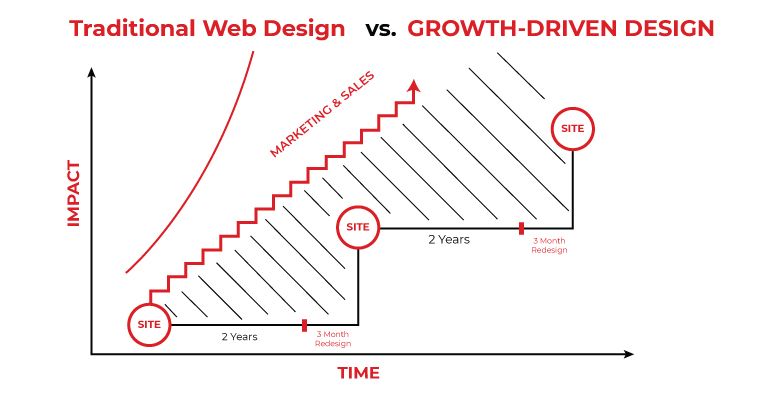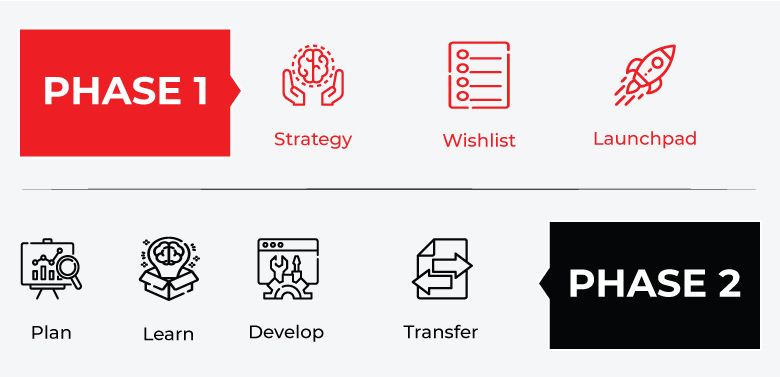What is Growth Driven Design?
Growth Driven Design Methodology (GDD) is an agile way of developing or redesigning and maintaining a website in intentional increments. It is about making continuous, adaptations and improvements to your website based on data as opposed to try to make every element of your site perfect and then leaving it to sit static online for a few years.
Growth-driven design aims at creating a peak-performing website with less waste, in half the time. They work on getting a faster initial launch, and follow the principle of continuous improvement of the site based on user data. As a result, the website is optimized for best performance and results.
But what drives the need for growth-driven design?
The users. For most business in the market in today’s digital age, the website act as their centerpiece of marketing activities. This is where their future clients and target audience come looking for information regarding their products and services.
Developing a traditional website in such cases will stall their audience because of the long duration required for its development. During this period, you cannot attract or convert leads. Also, once you have spent so much time adding all the bells and whistles, it becomes difficult to make major changes without it becoming a time-consuming project. You cannot respond quickly to changing business needs and customer demands.
You lose agility, you lose business.
Growth-driven design give you freedom from this static approach to introduce an ongoing process of redesigning your website. This process is:
|
ITERATIVE A growth-driven site is developed and continually improved over a perpetual cycle of one or two weeks. |
|
USER FOCUSED The improvements made in the websites are not just based on the company’s marketing teams, but often on the user data as to how prospects are engaging with your site. |
|
OPTIMISED A growth-driven site is in a continual state of optimisation, to give prospects what they’re looking for, and deliver the highest number of visitors, leads and customers. |
Investment in the Growth of Your Business
Growth-Driven Design is an investment that aims to produce month-over-month growth. Your website returns becomes higher as you continue to measure, iterate and act.

Source : Article 1.0 Luke Summerfield, Traditional vs. Growth Driven Design
Comparing Traditional Website Design with Growth Driven Website Design
Benefits of Growth Driven Web Design
Compared to the traditional website development process, the GDD approach has faster time to market, is data-driven, and more relevant to the users. It offers the following benefits:
Put user experience and conversions front and center
The growth-driven design approach avoids the risks of traditional website building. You don’t spend a lot of time building and perfecting a website that ultimately doesn’t cater to your customers. With growth driven web design, you build fast and launch fast.
Then you begin collecting data on how your visitors use the site, which pages they visit, what the search for, which CTAs get clicks, and more. All this data allows you to consistently keep tweaking the site, to make it as close to what your users expect. Your site gives them exactly what they want, building trust and driving conversions.
Launch on-time and on-budget
Traditional website development projects almost always roll beyond planned launch dates. With growth driven web design, you have a quick first cut with the basics in place. It can be built and launched on time, and within budget. And you don’t invest time and money into building features on guesstimates. You actually take time to find out what your users want, and then invest in developing just the right ones.
Continuously learn and improve
You can constantly researching, testing and learning about our visitors to inform ongoing website improvements. And that ensures that your website design is optimal for conversions at any given time.
Growth-Driven Design is tightly integrated with marketing and sales. What you learn about visitor behaviour helps inform not just the website design, but also improved marketing and sales strategies. This helps all your lead generation channels operate in tandem, ensure a consistent user experience, and optimal results.
How We Do It
As a growth driven design agency, our design approach to websites is built on-top of the SCRUM agile process and weaves together various concepts into a comprehensive and highly effective web design methodology. It is broken into two main phases:

PHASE I
Within the first phase, there are three stages to growth-driven design: strategy, wishlist, and launch pad.
Strategy
In this stage, a rock solid foundation is built by focusing on the following aspects of an organisation:
- Website performance goals that you are trying to achieve
- Developing detailed persona profiles for the different groups visiting your site
- Analysing the current website performance and doing a quantitative audit of the good and the bad aspects
- User research focused on understanding their goals, motivations, and pain points
On the basis of the above aspects, we create fundamental assumptions around your user behaviour to identify the value propositions for each offer, locations and devices users will be using to access your website, and what information they are looking for.
These assumptions in return influence the development of the global strategy for the website as a whole, as well as specific page-by-page strategy for each major page on the site.
Wishlist
The next step is to create a wishlist of the experiences that you’d like to include on the site. For this we have a brainstorming session to identify the items you need to achieve your marketing goals, irrespective of money, time, and development skills.
A typical wish list will have 50-150+ items on it. Then we help filter and prioritise this, to determine what to include in your launch pad website, and what list items will wait until a later phase in the GDD process.
The Launch Pad
Next is the development of an initial launchpad site, which includes all the high priority components. The size and complexity of the launchpad website varies depending on your wishlist and type of website. Shorten your list to 20% of the original. This short list makes an impact and launches quickly so you can continue to learn about your users and improve the site.
The launch of your website is the starting point for all other activities and improvements to be done from now on. The idea is to avoid falling into the "analysis paralysis" trap, and put up a site that can serve as a good starting point on which to continuously improve.
PHASE II
Continuous Improvement
Once the launch pad website is up, the next step involves continuously experimenting, learning, and improving on your website. This is done through a four-stage process:
|
PLAN This involves identifying the most impactful items from the current data on user behaviour. You can map out behaviour data to website performance goals, and pick the items that will cause an immediate improvement in chosen site performance metrics. |
LEARN In this phase, you review the information collected about your website visitors.Did your change impact as you expected, why or why not? Based on the results, what did you learn about your visitor? What did you learn about them that you didn’t know before? |
|
DEVELOP In this step, your team gets together to start completing each action item that you selected in the planning phase. Experiment with each action item you implemented. Measure the impact it has on the performance of the website. |
TRANSFER The last step in the cycle is to now transfer any impactful information you’ve learned in your iteration cycle to other parts of your business. Review previously completed action items to see if you can find any patterns about your users. |
Once these steps are followed, the GDD cycle is complete. Then we go back to the beginning and start planning the next cycle.
This cycle repeats itself over and over again each time with a better end result and more learning about your visitors. The more cycles you can complete, the more impact your website has.
Tools Used
Below is not the exhaustive list of tool and we do work with a long list of other tools , however this list provides you an idea of key tools that we use.
| Audit | Ahrefs, SEMrush |
| Content | Adobe CC, Ceros, Office, Google tools |
| Website Design and Development | HubSpot CMS or WordPress |
| Data Analytics | HubSpot, Google Analytics, Hotjar |
| Marketing Automation | HubSpot |
| Project Management | Asana, Trello, Basecamp, or any tool that you use |
| Communication |
Zoom, Slack, Email |
FAQs
Why is website redesign necessary?
Let your website stagnate for too long and not only will your organization look out-of-date, search engines will most likely rank you lower, your visitors will start getting bored and will start reducing engagement and over time, it will be, to the point where you the effectiveness will reduce to being minimal.
Your website is like a smartphone. With all of the rapid advancements in technology in this digital age, you need to upgrade your phone every two years. The same holds true for your website, and you should expect to redesign it every 18 to 24 months.
Yes, you read that right - redesign your website every 18 to 24 months to ensure engagement of your future and current clients.
With growth-drive websites, redesign is not a year-long horror project with an inflated budget. Rather it’s a quick and agile project that continuously optimizes itself to bring better results.
How much does a Growth Driven Website cost?
Asking this question is like asking what a house will cost. How many bedrooms the house will have? What size of build? One story or two? Company websites are complex, and made more so when things like online sales, filtering, unique functionality and other features are involved. So, while there’s no simple way of knowing what you might pay until the project is scoped in detail, we can tell you that there’s a difference between what you’ll pay for a “traditional” website build and a growth-drive design (GDD) website build and that GDD launch pad website costs less than the traditional website build and generates much more ROI.
The ROI comes in three forms:
- The investment is optimised - because you build features that you know your users need. You’re spreading the cost of a website out over time. There’s a foundational investment “first round” - to build the launch pad site, but smaller (and consistent) monthly costs thereafter as you continually improve it
- You’re generating leads more quickly, thus getting a better return on investment
- You eliminate the opportunity cost of being stuck with a massive, unwieldy website. You can change things fast, capitalise on opportunities, and keep your site fresh and streamlined at all times.
The cost of a GDD project will depend on two things:
- How much work needs to be done to create the launch pad website
- What is required to achieve peak performance for your site.
How do I prioritise what to have in the launch pad?
The simplest way to do this is to start with the 80/20 rule and identify the 20% of the items that will produce 80% of the impact on the site. Then, separate the list into "must have" versus "nice to have" items. Anything on the "must have" list will go into the launch pad site.
Growth Driven Design with Grow Digitally
Are you stuck with a website that is not generating revenue? Are you stuck with a clunky website and dreading a large redesign project? Book a time slot convenient to you below and we can discuss how growth driven websites can get the results you are after.
- Understand your growth driven design readiness
- Understand how GDD can help achieve your goals
- Find out how Phase 1 (Strategy, Wishlist and Launchpad) process will accelerate your achievement of ROI objectives
- Deliver exceptional user experiences in a prioritised manner, and increase conversions with continuous improvement cycles




